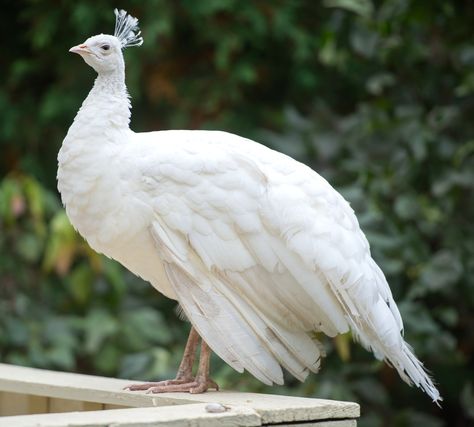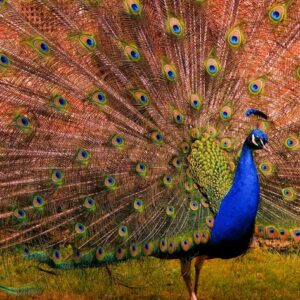The White Peafowl is an extraordinary and visually striking variation of the Indian Blue Peafowl (Pavo cristatus). Known for its immaculate all-white plumage, this bird is a result of a genetic condition called leucism, which causes reduced pigmentation while maintaining normal eye color, distinguishing it from albinism. White Peafowls are not a separate species but a color variation that has captivated humans for centuries due to their ethereal beauty and majestic presence. They are often kept in ornamental collections and estates, where their unique appearance makes them a centerpiece of admiration.
Physical Characteristics
General Appearance:
The White Peafowl’s pure white plumage sets it apart from the more colorful Indian Blue Peafowl:
- Males (Peacocks):
- Males are larger and display a long, ornate train of pure white feathers. The train is adorned with delicate, eye-like patterns that shimmer in the light, creating a breathtakingly elegant effect during courtship displays.
- The head, neck, and body are also pure white, with a faint sheen that adds to their luminous appearance.
- They have a tall, upright crest of white feathers on their head, enhancing their regal look.
- Females (Peahens):
- Females are smaller and lack the long train but share the same pristine white plumage.
- Their understated elegance is accentuated by their shorter crest and simpler posture.
Both sexes have long legs, a sharp beak, and striking white feathers that glow against natural backdrops. Their eyes are dark, unlike albino birds, due to the presence of normal pigmentation in their irises.
Habitat and Distribution
White Peafowls are found in captivity and managed environments worldwide, as they are bred primarily for ornamental purposes. They are descendants of the Indian Blue Peafowl, and in the wild, they thrive in similar habitats, such as:
- Deciduous forests
- Open grasslands
- Agricultural fields
- Urban gardens and estates
Although rare in the wild, White Peafowls are a testament to the genetic diversity within peafowl populations.
Behavior and Social Traits
White Peafowls exhibit the same behaviors and social structures as their Indian Blue counterparts:
- Social Structure: They are highly social and live in small groups, typically consisting of one dominant male and several females.
- Activity: Diurnal in nature, they spend their days foraging and their nights roosting in tall trees or elevated areas for safety.
- Foraging: These omnivorous birds feed on grains, seeds, fruits, insects, and small reptiles, playing an essential role in pest control and seed dispersal.
Courtship and Reproduction
Like other peafowls, White Peafowls are known for their dramatic courtship displays, especially males:
- Courtship Displays:
- Males fan out their long, shimmering white trains in an impressive semicircular display, often accompanied by rhythmic movements and calls to attract females.
- The train’s intricate patterns, though subtle due to the white coloration, create a mesmerizing visual effect.
- Breeding:
- During the breeding season, females lay 3–6 eggs in a ground nest hidden among vegetation.
- The incubation period lasts about 28–30 days, during which the female provides all parental care.
- Chicks:
- Peafowl chicks are precocial, meaning they can walk and forage soon after hatching but remain close to their mother for protection and guidance.
Cultural and Ornamental Significance
White Peafowls have been symbols of purity, beauty, and rarity for centuries:
- In many cultures, their white coloration is associated with elegance, mysticism, and divine protection.
- They are commonly kept in gardens, estates, and zoos as ornamental birds, admired for their unique and captivating appearance.
Conservation and Breeding
Although not naturally occurring in the wild, White Peafowls are bred in captivity by selective pairing of leucistic Indian Blue Peafowls.
- Challenges in Breeding: The rarity of the leucistic gene requires careful management to maintain the population of White Peafowls without inbreeding.
- Conservation Connection: Their popularity in captivity raises awareness about the importance of preserving the habitats of their wild counterparts, the Indian Blue Peafowl.
Conclusion
The White Peafowl is a breathtaking example of nature’s diversity, showcasing the beauty of genetic variation within a species. With their luminous white plumage and captivating courtship displays, they are a symbol of elegance and grace. Whether in ornamental gardens or zoological collections, these majestic birds continue to inspire awe and admiration, reminding us of the wonders of the natural world.









Reviews
There are no reviews yet.